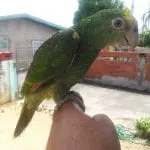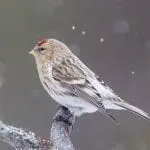Scientific Facts
| Common Name: | American goldfinch |
| Scientific Name: | Carduelis tristis |
| Life Span: | More than 10 years (in captivity) |
| Size: | 4 to 5 inches long |
| Habitat: | Weedy fields, overgrown meadows, open fields, sub-urban habitats, and scrub forests |
| Country of Origin: | North America |
Physical Description

The American goldfish is a tiny bird found in North America. A member of the finch family, this bird is migratory as it ranges from mid-Alberta to North Carolina throughout the breeding period. From the south of the Canada-US border to Mexico throughout the winter.
The bright yellow feathers of the American goldfinch are easy to identify, but since most female orioles, warblers, and other finches could be yellow also. Still, the goldfinch has special field marks that set it apart from other birds.
The thick cone-shaped beak of the American goldfinch is sharp-pointed and will change in color as the season changes. This beak is either peach or pale pink in summer but turns a dark gray-black in winter. The male American goldfinch has a black cap on the crown and forehead, with the bright lemon-yellow abdomen, back, sides, and chest.
The black wings come with 2 white wing bars, and the black tail is bordered with white. A female American goldfinch is a lighter olive-yellow with dull wings without a black cap. However, every bird, whether it’s a male or female, has a whitish rump.
During winter, the male American goldfinch looks like a female as it has a darker beak. When the bird undergoes the process of molting, its plumage will turn into something patchy and splotched.
The young or hatchlings also look like the female American goldfinch, but they have a scruffier plumage. Their underparts and wing bars look tan instead of creamy white. Likewise, they may also have sparse and bushy eyebrows.
This bird can also be too vocal at the feeders. It will make calls like the fast, high-pitched chirping with undulating short buzzes or pitch. Long warbling sounds are more common when it’s time to breed that happens in spring until early summer.
Color Pattern
The adult male American goldfinch in spring to early summer is bright yellow with a black forehead and black wings with whitish markings. Also, it goes with white patches on top and underneath its tail.
Meanwhile, the adult female is pale yellow underneath and olive on top. During winter, these colors will turn to drab, streak-free brown with dark black wings and pale-colored wing bars.
Similar Species
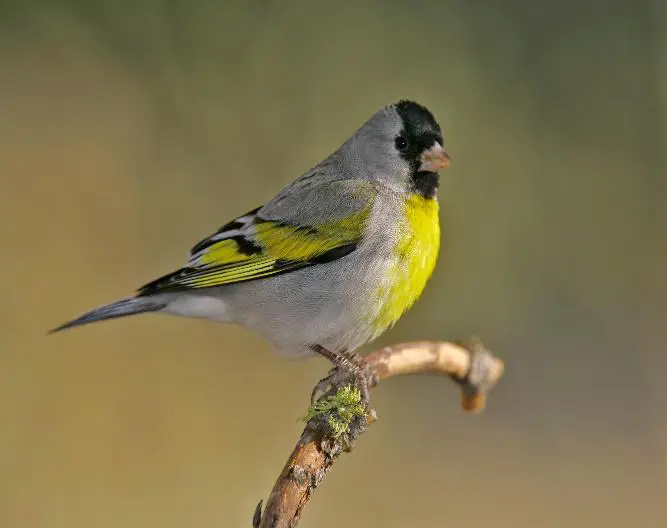
The male American goldfinch looks unique and too different from other finches in North America. It shares the same color as Wilson’s warbler that is also in the bright yellow shade with a black cap. The only difference is that Wilson’s warbler doesn’t have a finchlike beak and the dark wing pattern that the American goldfinch has.
A female Lawrence’s goldfinch is grey just like the non-breeding adult female American goldfinch, but the latter has buffier wing bars and a different whitish pattern in its tail. Likewise, the call notes of an American goldfinch are so different from the songs of other birds.
Habitat and Distribution
The American goldfinch is among the most widespread and common backyard birds living in North America. You may find this bird hopping or perching in the open fields, sub-urban habitats, and scrub forests. It can also be found in the overgrown meadows and weedy fields where the plants like asters and thistles are common.
The bird can also be found in roadsides, cultivated regions, backyards, and orchards. The American goldfinch is also fond of visiting the feeders anytime it wants, but it happens mostly during winter.
Life Cycle
The American goldfinch mates later than the bird. It’s a seed eater like the purple finch and does not nest until the mid to late summer. This period is the best nesting time for this species because it will need more seeds a variety of plants, including weeds. Since it mates late in a year, the American goldfinch typically has just one brood each year.
The female goldfinch will build a cup-shaped nest on the tree’s fork while the male is watching her. Her nest is made of bark and plant fibers. The bird will spend up to 6 days in building a perfect nesting site for itself.
Once the nest is ready, the female will jump in and lay 4 to 6 eggs. The male will be there to feed the female while she’s incubating the eggs. Then, the eggs will hatch in 2 weeks. The hatchlings are born without feathers. Their eyes are still closed for now and will open after 7 days. The hatchlings are ready to leave and fly in 10 to 16 days.
Behavior
An American goldfinch tends to fly with a unique and undulating pattern. When the bird flies, it seems to form a wave-shaped route. This includes some wing beats that elevate the bird, folding in its wings, and sliding in an arc. Then, the bird will repeat the pattern.
The American goldfinch often makes a sound at the flapping stage of its flying pattern then it stays quiet throughout the coasting stage. During the flight, it makes the sound “ti-di-di-di” or “per-twee-twee-twee,” ending with silent periods.
This goldfinch doesn’t show up with aggressiveness when predators are around its territory. Instead, the bird reacts to the situation with an alarm call. Its common predators are snakes, squirrels, weasels, and blue jays. All these animals might destroy the eggs and kill the hatchlings. Cats and hawks pose a danger to young and adult American goldfinches.
This bird may congregate in the small to medium-sized mixed flocks in fall or winter. It goes with the common redpolls, pine siskins, and other finches having the same dietary requirements as this goldfinch.
The bird is mildly hostile while feeding and may become very territorial during the breeding period, occasionally snapping or lunging at the nearby birds to defend its feeding area. The flight pattern of an American goldfinch is undulating and bouncy. It often calls loudly as it flies.
Moreover, this bird is diurnal. Meaning, it is most active throughout the day. It comes with impressive flying skills as it dips and rises in the wavelike pattern while it soars. When it is not airborne or perching on plants, it will hop along the ground to looks for seeds it can eat. This bird has 6 different vocalizations, such as the “po-ta-to-chip” call.
Life Span
The wild American goldfinch lives for 3 to 5 years. In captivity, it can live for up to 10 years or a bit longer.
Perception and Communication
The American goldfinch communicates with one another through calls and songs. It shows 6 various kinds of calls: threat cries, contact calls, distress, and alarm cries, courtship & pre-coition calls, songs, and feeding calls. One of these is the sound “per-chik-o-ree.”
Contact calls are more common than the other sounds the American goldfinch can make. Its song is common as well when the bird is breeding. It is described as “warbling” or “rambling.”
The songs of an American goldfinch are a lengthy sequence of musical phrases that the bird often repeats randomly, the same with the lesser. However, it is still unknown to mimic or imitate other birds.
It makes calls both while in flight and perched. After hatching, the teenage American goldfinch demonstrates begging calls when it is hungry. When it feels threatened or distressed, it has a distinctive call. It also communicates when enticing mates through its feather’s coloring and flying displays.
Sociality
An American goldfinch is gregarious in the non-breeding period when it’s usually found in big flocks, typically with other birds. Its social hierarchy, gauged by the number of aggressive encounters won by every bird, tends to the male being dominant in a non-breeding period.
During the breeding period, the American goldfinch is living in the loose colonies. While the nest is under construction, the bird will act aggressively towards other male American goldfinches that may enter or disturb its territory. The bird will drive the other birds away while the female will react in the same manner towards other females.
Its aggressiveness subsides after laying the eggs. Its social hierarchy within the breeding period usually has the female dominating over the opposite gender. Dominance might change depending on the resource’s value. A study in 1987 revealed that starved subordinate birds were dominant in the competitions over the feeder access.
The American goldfinch will indicate its level of aggression through multiple displays. The head-up display in which the neck and legs are a bit extended, the bird shows minor aggression and is usually performed by an encounter’s victor.
Its carpals-raised display comes with its neck retracted, and the carpals elevated; displayers are likely to attack its opponent. Its head-forward display is where the legs are bent, its neck extended, and beak closed.
In higher intensities, the bird lowers its neck, its beak is pointed in its opponent, and 1 or both wings are elevated. In some cases, the neck is retracted, the beak opened, its body feathers sleeked, and its tail has been fanned and elevated slightly.
The bird also shows aggression by showing its body’s front to another person. Attacks involve pecking at the feathers, supplanting its rival by landing beside it, and flying steeply with its feet and legs extended, necks extended, and beaks open. Avoidance behaviors involve showing only the side of its body to an invader, lean away, flex the legs, retract its neck, and point its bill down.
Breeding
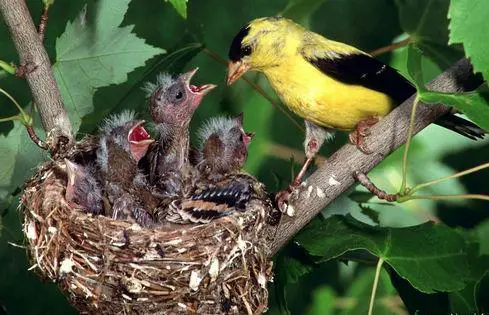
The American goldfinch starts its breeding period than other finches and later than other native North American birds, aside from the sedge wren. It might be associated with the stable supply of the seeds in late summer because the seeds show the majority of its diet.
During the breeding period of this bird in summer, the male American goldfinch develops brightly colored feathers to entice a female. The bird will lay 2 to 7 eggs.
The newborn goldfinches will fly around 2 weeks after the eggs hatched. However, most will go back to their nests and stay with their parents for around 30 days before it leaves the nest for good.
Like other birds, the American goldfinch follows a courtship ritual. This includes aerial tricks and singing, which the male will do to catch a female’s attention and impress it. The flight display starts when the male bird pursues its prospective mating partner. The male will fly in a zigzagging evasive pattern. The bird can signal its fitness and quality, both in its present body condition and genes through its plumage and beak’s color. When the female responds positively to the courting male, they will both fly in big circles while the male sings during the flight.
When the male finds a good mating partner, it will choose a territory and mark the boundaries through warbling while flying from one perch to another. After marking the boundaries of the territory, the male American goldfinch will perform 2 flight displays. First, it repeats a low and flat flight; then, it flies in the exaggerated type of a normal flight. The bird will tuck its wings near to its body, dropping downward and catching itself as the bird spreads its wings and slide up, making some loops. 2 to 3 pairs of may combine their respective territories in a moveable colony that may help them defend the whole area against the predators.
The female American goldfinch will make a nesting spot in late summer. It puts the nest within the branches of a deciduous tree or shrub that is 10 meters or 33 feet away from the ground. The construction of the nesting spot will take almost a week wherein the female goldfinch works on 10 to 40 minutes increments. The male will frequently fly with the female while she collects the nesting materials, but it carries some materials necessary for building the nest. However, it never helps the female in the job.
The nest’s external shell is made of weed, bark, grass, and vines. The inner diameter of the nest is roughly 6.5 centimeters or 2.6 inches. Its rim has been reinforced with the bark bound by the spiderwebs plus some caterpillar silk. The cup has been lined with plants like thistle, cattail, and milkweed.
The nest will be tightly woven as it could hold some water. Therefore, the hatchlings may get drowned after a rainstorm when the parents don’t cover their nest.
Only the female will incubate the eggs, but the male will responsible for feeding her as she can’t leave the nest. In most cases, a mating pair raises just one brood in a year. The eggs are expected to hatch in 12 to 14 days after the incubation period.
The eggs of an American goldfinch are light bluish-white that sometimes have pale brown spots. While the female bird deals with building the nest and incubating the eggs, the male bird will feed not just the mother but even the hatchlings. The mother will help him in feeding the babies.
In the long run, the role of the female goldfinch in feeding the babies will decrease, so the male will take charge and provide more food for the young. The hatchlings will leave the nest in 11 to 17 days after hatching.
The female American goldfinch will feed the hatchlings with regurgitated seeds or insects while they grow. The hatchlings will develop fast as they will open their eyes in just 3 days after the eggs hatched and finish the development of the olive-brown young plumage in the next 11 to 15 days.
They will start to practice some short flights near to the nest. In 3 weeks after they fledged, the male American goldfinch will still feed them who will look for them by heeding to their fledging song. The hatchlings will stop making this sound once they know they can take care of themselves.
This bird species sometimes become a victim of brood parasites, especially the brown-headed cowbirds. According to a study, 9% of the nests made by the American goldfinch had some eggs of the brown-headed cowbirds. It may likely evade parasitism partially due to its late breeding period.
The American goldfinch can also become a poor host for the brood parasites. The studies conducted showed low hatching rates for the eggs of cowbirds and zeroed fledging success. It happens despite the lack of common behavioral adaptations for brood parasites in this bird.
The scientists believed that the incapability of the cowbirds’ hatchlings to survive is the result of malnutrition. The seed-rich diet of the goldfinch hatchlings differs from the ordinary insect-rich diets of the other hosts.
Food and Nutrition
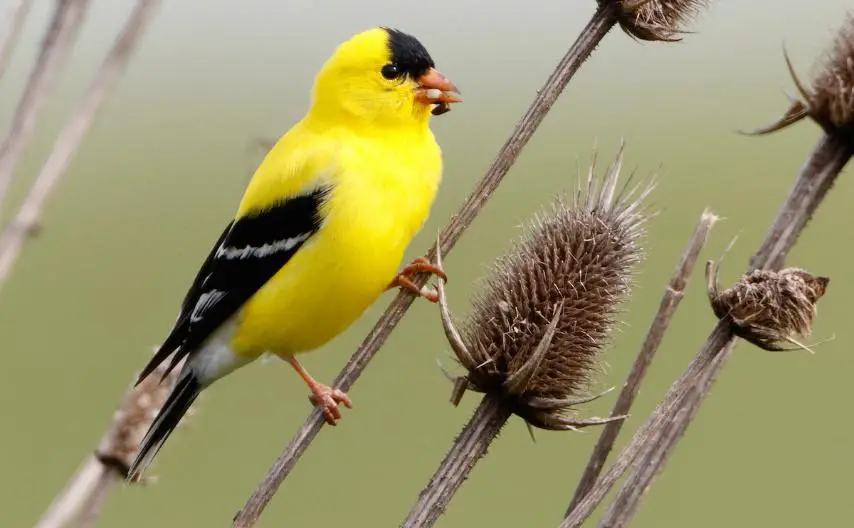
This bird has been classified as a diurnal feeder. The Cornell Lab of Ornithology said the American goldfinch is among the strictest vegetarians of all birds. This species is primarily granivorous but will eat insects in some cases. The female bird feeds its hatchlings with the same kind of food as a good source of protein.
The usual diet of an American goldfinch consists of seeds coming from various plants, including grasses, weeds, and trees. Examples are dandelion, teasel, thistle, ragweed, cosmos, mullein, sunflower, goatsbeard, and alder.
However, this bird also eats maple sap, tree buds, and berries. It may also eat foods from the bird feeders offered by humans, which is more common during winter. For this case, the bird may eat Niger or thistle seed.
This particular dietary preference is making the American goldfinch a great helper in gardens and farms wherein the bird’s voracious appetite eliminates the need for dangerous chemicals like herbicides.
Compared to other finches, the American goldfinch will use its feet extensively when eating. The bird usually hangs from the seedheads as it feeds itself. This will allow the bird to reach the food and eat it with ease.
In spring, the American goldfinch will feed on the catkins that hand from canes and alders by pulling up one using its bill and toes to keep the catkins steady against the twig. This particular dexterity lets the bird make the most of the available food sources that are difficult to access for the competitors. Thus, it helps increase the odds of an American goldfinch to survive.
Tips for Feeding and Attracting an American Goldfinch
An American goldfinch is one of the easiest birds that entice the backyard bird feeder.
An American goldfinch is fond of the Niger seeds for its rich calorie and oil content. However, this bird is not a picky eater as it will consume whatever kind of food you put in the feeders.
Try to get the bird feeder with more perches and will support many birds at once. Be sure to clean it often to prevent diseases from spreading and having the foods look dirty and unappealing because of clumping and mold.
If you’re after a very spectacular show, put more seeds in the feeder before the storm comes in. The bird goes into the feeding frenzy when it feels the weather seems to goo bad.
Goldfinches might make nests in pine trees and thick shrubs. Therefore, it is best to have their favorite plants growing somewhere in your backyard. There should be sunflowers, milkweed, and thistle.
The American goldfinch takes up residency in the birdhouses. The openings of these houses must be around 1 ½ inch in diameter. If possible, look for birdhouses that have guards that will secure the bird from predation.
The American Goldfinch and Its Role in the Ecosystem
Since the diet of American goldfinch is composed of nuts and seeds, it helps a lot in dispersing the seeds. The brown-headed cowbird serves as a parasite to American goldfinch. The cowbird often goes into the nest to destroy the eggs and replace them with her eggs. Therefore, the American goldfinch will unknowingly raise the cowbird’s hatchlings.
Reported cases of parasitism involving the cowbirds accounted for 9.4%. However, the researchers didn’t find successful cases. Documented interior parasites involve avian trichomoniasis, and a protozoan parasite caused intestinal coccidiosis.
The American Goldfinch and Its Positive and Negative Importance to People
This bird brings fun to birdwatchers as they watch it eating at the feeders. There are no adverse reactions of the American goldfinch on people.
Conservation
The American goldfinch is not an endangered or threatened species. Despite that, the animal still faces grave hazards. Due to their extreme appetite for seeds, they are more prone to poisoning due to the overuse of fertilizers, herbicides, and other hazardous chemicals.
Continuous development of the grasslands and fields led to reduced habitats for the American goldfinch. Outdoor cats and window collisions are some other issues associated with this bird.
Migration Pattern
The populations of these birds in southern Canada and the southern United States will migrate seasonally. However, the birds may stay longer in some areas during winter for as long as they are getting enough food. These birds adopted the habit of going to other areas, such as in eastern and northern Mexico, where bird feeders are available.
Predation
Common predators of the American goldfinch include the blue jays, eastern garter snakes, weasels, and American kestrels. Feral and domestic cats can also feed on this bird. This goldfinch can make a defensive call, but it is often non-aggressive to predators.
Interaction with Humans
The American goldfinch has been found in the residential regions across its range. Backyard birders entice it by using feeders that contain Niger seeds or planting grass or perennial plants like cosmos, zinnias, globe thistle, or bee balm that produce seedheads loved by finches.
The goldfinch isn’t threatened by people’s activities. Its range is widespread across its range. Clearing the forests and woodlands, benefited this bird despite the harm it can cause to other species. This activity caused a decreased in the populations of the neotropical migrants while doing a favor for short-distance migratory animals and permanent occupants.
It benefited the American goldfinch as a short-distant migrant. Since the formed open areas are favorable habitats for this species, the bird will likely stay here for a long time. Also, these areas will give it a stable source of food.
Where to Get One?
The American goldfinch is rarely kept as a pet bird. So, you may likely find it from professional avian breeders. These individuals are easier to find through the web. Getting your pet from these sources is a better choice as they can help and give you tips to raise your pets properly and keep them healthy and happy.
How to Care for an American Goldfinch?
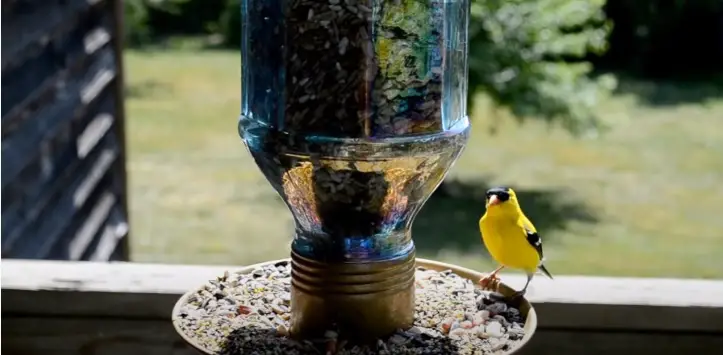
In the zoos, the American goldfinch requires the same care to its cousins and other songbirds. This bird is a famous fixture in the walk-through aviaries due to its bright coloration. In aviaries, this bird shares its space with some other species.
Walk-through aviaries are big enough for different species to share space or establish their territory. Its enclosure may also contain various trees, bushes, water features, and bushes. Zookeepers will feed this bird a diet consisting of berries and seeds.
Housing

The American goldfinch is a great bird to look at due to its amazing acrobatic stunts. While feeding in the woods, it clings upside down on the heads of plants like sunflowers. Then, it moves to a weed stem and feeds in the standing, upright posture. In terms of artificial feeders, it likes hanging on the tubular structures, particularly those feeders equipped with perches.
This goldfinch is quick to entice and make it stay in the backyards. As a seed-eater, all you need to do is to give seeds in the feeding stations. You will have fun seeing this small songbird every day for sure.
Birdhouses with feeders containing hulled sunflowers, particularly the thistle and black oil seeds, will make the American goldfinch happier and eager to stay in your home. Although, this bird normally feeds in weedy meadows and open fields. Also, the animal loves the bird tables and window trays that contain millet, sorghum, cracked nutmeats, and canary seed.
The shelter is crucial for the survival and growth of this bird, especially during its nesting period. Of course, the best one is something natural like vines, shrubs, trees, and hedges. These are attractive habitats for the American goldfinch. Dead branches and trees could serve as perfect homes for this species, particularly when you plant vines on the bottom.
Before you decide on constructing a birdhouse for this bird in your backyard, you must check your lawn or garden. After that, find out if the area has spots for shelter and breeding. Ask yourself if you can give stable water and food for the bird.
A birdhouse must be made during autumn, can stand through winter, and ready to use during spring. On the other hand, you can build and get the birdhouse ready anytime. You must put it on the metal posts away from the loud and noisy places to keep the cats and other animals at bay.
A bird feeder is also a major food source for an American goldfinch. You may settle for a tube feeder for the meantime. A transparent tube made of plastic is suitable as it will let you know whether the food inside is still enough or requires refilling.
A tube feeder is good to use in enticing a small songbird, such as the American goldfinch. Keep in mind that moisture will easily result in spoilage if you don’t protect the food from moisture.
Also, the birdhouse and feeder are incomplete without a good water source. Bird lovers out there give ample food, but they ignore the significance of water. Though they can get find some water provided by dew, wild food, and rainfall, other water sources will benefit them a lot. A birdbath using warm water is also a good choice for birds during winter. Aside from drinking, an American goldfinch needs water for bathing. Also, bathing is crucial to help the bird keep its feathers healthy and shiny.
Fun Facts About the American Goldfinch
- This is the one and the only finch which can molt its feathers twice every year that occurs in late winter and late summer. The bright yellow plumage of a male American goldfinch indicates the upcoming warm season.
- The American goldfinch breeds later than other birds originating in North America. It waits to nest until June and July when plants like thistle and milkweed produced their seeds. The bird will add these fibers into the nests and feed them to hatchlings.
- Goldfinch is one of the strictest vegetarian birds. It chooses a pure vegetable diet and occasionally eats insects.
- When the brown-headed cowbird lays eggs in the nest of an American goldfinch, the eggs will hatch, but the hatchlings often struggle to survive as many of them die after 3 days.
- The cowbird hatchlings cannot survive on an all-seed diet, which the goldfinch feeds its young.
- The American goldfinch moves south during winter after the pattern, which appears to coincide with the areas in which the temperature for January is not cooler than 0 degrees Fahrenheit.
- A pair of goldfinches make similar flight calls. They can distinguish the members of different pairs through flight calls.
- The oldest American goldfinch was almost 11 years old when the researchers recalled and redistributed it during the banding activity in Maryland.
FAQs
How long does the American goldfinch live?
Sadly, the American goldfinch is one of the birds with a shorter lifespan. In the wild, it can live for 3 to 6 years but may go longer for up to 10 years in captivity.
Is the American goldfinch an endangered species?
This bird is not an endangered species as of now. Its population within the range stays stable and abundant.
Does the American goldfinch migrate?
Its populations in the south of the US are residents, while the populations in the north tend to migrate. They do by day in groups, and most of the birds living in Washington leave the area during winter.
What does the American goldfinch eat?
The American goldfinch is a seed-eater. It likes the seeds of sunflower, elm, and thistle.
What are the predators of the American goldfinch?
This tiny bird is a common victim of reptiles, mammals, and even larger birds. Their predators are blue jays, weasels, American kestrels, cats, and eastern garter snakes.
How many eggs does the female American goldfinch lay?
The American goldfinch has just one brood because of its late breeding period happening every year. On average, a female goldfinch lays 2 to 7 eggs.
Is an American goldfinch aggressive?
The American goldfinch is quite sociable to other birds and rarely shows aggression (only during the breeding season). For humans, feeding it well and giving it a supply of clean water and a nice birdhouse may eventually help in taming the bird.
Does the American goldfinch love being held?
The American goldfinch is rarely treated as a pet. However, the bird is more likely to behave with proper care and taming.


